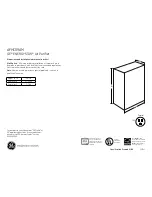
TTJ-0198 (10/97)
(Page 20 of 64)
within a plastic block to supply a small amount of heat
to the bulb area to prevent long "off cycles" in the "Cool-
Fan Auto" (MoneySaver) position (see Figure 10.) A
current feedback through the fan motor windings during
"off cycle" completes the circuit to the resistor.
In the heating cycle, the heat anticipator is energized to
supply a small amount of heat during the "on" cycle.
This will open the contacts in the thermostat prema-
turely to maintain a closer differential between the "cut
in" and "cut out" temperature. The heat anticipator is
energized in the heating mode regardless of whether
fan is placed in the automatic (MoneySaver) or constant
run position.
RANGE:
Cooling Model Thermostat
(Part No. 618-224-00)
60°F (±2°) to 92°F (±4°),
TEST:
Cooling/Heating Models: Remove wires from ther-
mostat and check continuity between terminal "2" (com-
mon) and "3" for cooling. Check between terminals "2"
(common) and "1" for heating. Also check that contacts
in thermostat open after placing in either position. NOTE:
Temperature must be within range listed to check ther-
mostat. Refer to the troubleshooting section in this
manual for additional information on thermostat testing.
THERMOSTAT ADJUSTMENT
No attempt should be made to adjust thermostat. Due
to the sensitivity of the internal mechanism and the so-
phisticated equipment required to check the calibration,
it is suggested that the thermostat be replaced rather
than calibrated. Thermostat bulb must be straight to in-
sure proper performance.
Figure 10: RESISTOR
RESISTOR (Heat Anticipator)
Failure of the resistor will cause prolonged "off" and "on"
cycles of the unit. When replacing a resistor, be sure
and use the exact replacement. Resistor ratings are as
follows:
115 Volt - 5,000 ohms 3 watt
230 Volt - 20,000 ohms 3 watt
MONEYSAVER
®
SWITCH
(Rocker Switch) - See Figure 11
This rocker switch can be depressed to either YES or
NO. In the YES position you will get the most economi-
cal operation. Both the fan and compressor will cycle on
and off together, maintaining the selected temperature
at a more constant level and reducing the humidity more
efficiently in the cooling mode. This control will only op-
erate when the unit is in a cooling or heating mode. In
the NO position, the fan will run constantly as long as
the unit is in the cooling or heating mode.
TEST:
Disconnect leads from switch. Depress switch to func-
tion being tested.
1.
When YES is depressed, there should be continuity
between terminals "1" and "2".
2.
When NO is depressed, there should be continuity
between terminals "2" and "3".
Figure 11: ROCKER SWITCH
Summary of Contents for YL24J35A
Page 7: ...TTJ 0198 10 97 Page 7 of 64 COOLING LOAD ESTIMATE FORM...
Page 9: ...TTJ 0198 10 97 Page 9 of 64...
Page 14: ...TTJ 0198 10 97 Page 14 of 64...
Page 26: ...TTJ 0198 10 97 Page 26 of 64...
Page 27: ...TTJ 0198 10 97 Page 27 of 64...
Page 28: ...TTJ 0198 10 97 Page 28 of 64...
Page 29: ...TTJ 0198 10 97 Page 29 of 64...
Page 30: ...TTJ 0198 10 97 Page 30 of 64...
Page 36: ...TTJ 0198 10 97 Page 36 of 64...
Page 37: ...TTJ 0198 10 97 Page 37 of 64 WIRING DIAGRAM FOR MODELSYS13J33 YM18J34A YL24J35A...
Page 39: ...TTJ 0198 10 97 Page 39 of 64...
Page 40: ...TTJ 0198 10 97 Page 40 of 64...
Page 46: ...TTJ 0198 10 97 Page 46 of 64...
Page 47: ...TTJ 0198 10 97 Page 47 of 64...
Page 52: ...TTJ 0198 10 97 Page 52 of 64...
Page 53: ...TTJ 0198 10 97 Page 53 of 64...
Page 57: ...TTJ 0198 10 97 Page 57 of 64...
Page 58: ...TTJ 0198 10 97 Page 58 of 64...
















































